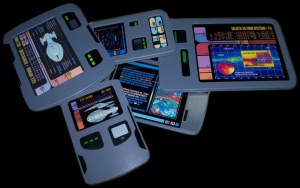PADD
From Star Trek: Theurgy Wiki
In its primary role aboard a starship, the Personal Access Display Device (PADD) was a handheld control and display terminal. Small, easily managed terminals and computers were in daily use throughout Starfleet, as a natural response to crew members' needs to:
- Execute hardware functions in a variety of locations
- Manipulate visual information and communicate that information to others aboard ship
Access to the ship computers and other pieces of equipment could be accomplished through the usual control displays and larger terminal screens, of course, but the PADD had become a convenient adjunct to those panels.
The standard small PADD was 10 x 15 x 1 centimeters and was constructed from three basic layers of imbedded circuit-composite material. All primary electronics, including multi-layer display screen, were bonded to the casing, a boronite whisker epoxy. If dropped accidentally, even from a height of 35 meters, a PADD would remain undamaged. Replaceable components were limited to three, the sarium power loop, isolinear chip and the subspace transceiver assembly (STA). In normal daily use, the power supply remained installed and is induction recharged. A full charge would last sixteen hours; if a PADD was about to exhaust its battery, it could set a memory flag in the main computer to transfer tasks to a working unit, or suspend them until a later time.
The total memory capacity of the isolinear chips was 4.3 kiloquads. Like the tricorder, the PADD could transfer its total memory to the main computers in less than one second if the need arose. The STA was used to maintain data channels between the PADD and the Ship's main computers. If taken on an away mission, the PADD could also perform quick uplink/downlink operations and function as a transporter lock on node. Data transmissions and computing factors could be shared with any other Starfleet device supporting the STA com protocols. As with the personal communicator, transmissions were encrypted for security purposes.
The display screen, 4.25 times larger than that of a tricorder, allowded for the manipulation of control graphics, numerical data and images by touch. Electrosensitive areas of the casing (colored brown on the standard engineering PADD) were designed for specific data movement and storage functions. They could also be used to personalize the default setup and single-crewmember security restriction. An audio pickup sensor permited voice input.
The PADD's control functions mimiced those of any multi-layer panel, insofar as the security restrictions for individual crew members were concerned. Properly configured with the Conn position bridge controls, a crew member could theoretically fly the ship from a PADD while walking down a corridor. While this would be an impractical exercise due to PADD memory limitations and the relatively small display screen, it was an example of the overall multiple option design philosophy established for Starfleet vessels.
This philosophy treated the ship as an integrated organism in which each component could be regarded as a cell in a body directed by a central brain, built with processing capabilities distributed throughout the neural network. Because of this, PADDs and many other handheld data devices were capable of accessing any data file or command program to which the user has authorized access.
Custom PADD configurations could be fabricated, allowing for larger sizes and areas. This was generally only done on a 'as needed basis' due to the variances in battery power and memory. A 'roll up PADD' design as well as many other designs were stored in the ship's memory. A broken PADD could be restored by a Replicator via molecular recollection and restoration. This process also restored the data that was on the PADD before it was broken.
Disclaimer Notice
PADD info used with permission of USS Wolff CO - granted Jan 30, 2017

